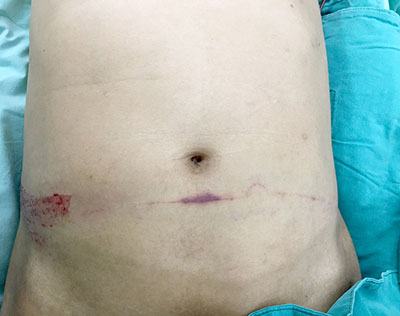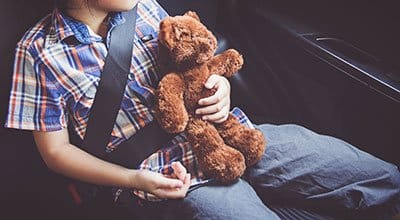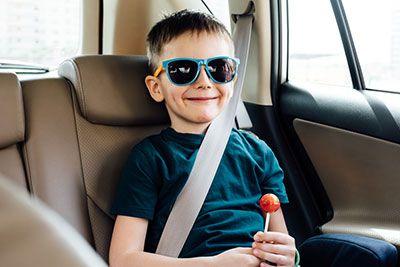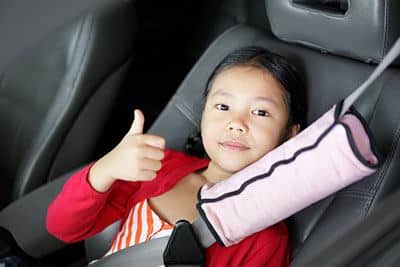Parents must place children in appropriate child restraint systems to keep them safe on the road. Once children overcome booster seats, it's time for a seat belt.
However, many parents ask: What is a seat belt syndrome child & can children suffer from safety belt injuries?
We discuss seat belt injuries in children, preventing the condition, and how to keep children safe in child restraints.
More...
Take away key points:
Table of Contents
- Seat Belt Syndrome in Kids: What You Need to Know?
- What is seat belt syndrome?
- Understanding seat belt syndrome better
- So, are seat belts dangerous for children?
- What does the "incorrect use of belts" mean?
- When was seatbelt syndrome first recognized?
- Why does the specific pattern of injuries occur?
- Can a vehicle seat belt increase risks in children?
- Recognizing children with the seat belt sign
- Safety tips to prevent seat belt syndrome
- Frequently Asked Questions
- The Bottom Line
Seat Belt Syndrome in Kids: What You Need to Know?
Kids can suffer from seat belt injuries if they don't fit the restraints correctly. Unfortunately, multiple injuries often result in fatalities. Please refer to the guidelines below to learn more about the topic and safety tips on keeping your children safe in the restraint systems.
What is seat belt syndrome?

Seat belt syndrome describes an injury pattern in restrained children involved in motor vehicle collisions. The syndrome is a combination of lumbar spine injury and intra-abdominal injury.
The state occurs when sudden deceleration forces combined with seat belt compression around the abdomen cause abdominal wall bruising, spinal fractures, and intra-abdominal injuries.
The leading cause of seat belt injuries in children is the improper and infrequent use of the corresponding seat belt restraints, leading to higher risks of multiple abdominal wounds, as the experts in the Pediatric Surgery division explain.
Understanding seat belt syndrome better
To better understand the severity of the condition, you can multiply a child's weight by the car's speed in a crash. For instance, if you're driving 30 mph and your kid weighs 40 pounds, they need 1,200 pounds of restraining force to keep the kid correctly secured during the collision.
If your kid is incorrectly placed in the vehicle, they are at increased risk of propelling into the back of the front seat, windshield, or dash or being thrown out from your car through the sunroof or window.
So, are seat belts dangerous for children?
No, seat belts are not dangerous for children when using restraints properly. Children restrained in lap/shoulder belts reduce the risk of fatal injuries by 45-50%, according to older studies by the National Highway Traffic Safety Administration.
However, child restraints might be fatal for kids with improper seat belt use. Thus, the 2022 statistics show that the incorrect use of car seats (and seat belts) increased fatalities in motor vehicle crashes by 7% (9,560 victims) compared with the same data in 2021 (8,935 deaths), as the National Highway Traffic Safety Administration claims.
What does the "incorrect use of belts" mean?
The incorrect use refers to:
- Lap-belt only fit
- Ill-fitting lap portion/shoulder portion
- Moving the shoulder belt behind the kids in the car seat/booster seat or under their arms prevents the straps from rubbing children's necks.
- Too much slouching in the restraint.
When was seatbelt syndrome first recognized?
The syndrome was coined in 1962, referring to the spectrum of injuries with lap belt restraints. The pertinent physical findings included the following injuries:
The syndrome was explained shortly after an increase in the seat belt system used by drivers and passengers. The condition was first noticed in adults. Although seat belts - especially lap belts were introduced in rear-facing car seats during the 1980s and 90s, various sources show the increased syndrome phenomenon in children.
Why does the specific pattern of injuries occur?
Seat belts prevent multiple injuries, including:

On the other hand, the lap belt has a specific design. The lap belt is created to cover the anterior iliac spine. Therefore, it can easily reach the abdomen or lower chest in the case of a motor vehicle crash.
A fast deceleration causes a child to hyperflex their torso over the lap belt, leading to abdominal wall compression. The flexion-distraction forces will also act on the lumbar spine and cause intra-abdominal injuries.
This is how the misuse of seat belts creates a pattern of abdominal injuries in kids. Again, you can refer to the study for a better understanding.
Can a vehicle seat belt increase risks in children?
Modern motor vehicles have replaced lap belts (2-point harness systems) with specific shoulder and lap belts (3-point harness systems). However, as the lap and shoulder belt system reduces the risk of the seat belt sign in kids, the restraints cannot completely exclude it. So, your children are at risk of severe injuries for multiple reasons.
Some of the injuries sustained in lap seat belt systems include:
- Poor fitting in the safety belt
- Spine fractures
- Intra-abdominal wounds
1. Poor fitting in the safety belt
If kids are not ready, yet parents restrain them in the adult seat belt systems, the shoulder strap will cover their neck, instead of chest and shoulder, according to the AAP.
In addition, rear seat passengers can quickly move the shoulder strap behind their back or under the arm, immediately converting the three-point harness into a two-point system.
Children tend to scoot forward in the car seat, enabling their knees to bend over the seat's edges. However, this state exacerbates the poor child's fit, thanks to the "slouch" factor.
While looking for the most comfortable seating position, kids can unconsciously jeopardize their safety. The belt won't be able to protect them correctly in the case of a car accident, and they can suffer severe injuries. You must supervise children's actions and take immediate steps if you notice improper restraint use.
2. Spine fractures
Spinal fractures are more prone to injuries in the pediatric population than in adults. The undeveloped pelvis is not as strong as the well-developed iliac spine. This way, the lap seat belt will easily reach the children's abdomen.
In addition, the abdomen has more subcutaneous tissues and thinner muscles than adults, increasing the risk of abdominal injury.
3. Intra-abdominal wounds
The increased head size (causing increased flexion around the belt system) combined with a smaller portion AP diameter of kids (driving a shorter distance for applying a deceleration force) also increases the risk of secondary compression of the internal injuries of intra-abdominal organs between the spinal column and belt system.
Recognizing children with the seat belt sign
The seat belt sign in kids indicates all children with higher risks of spinal and abdominal injury caused by motor vehicle crashes. The primary concern is the identification and management of life-threatening indicators.
For instance, a well-looking kid with a seat belt sign and abdominal tenderness must undergo an abdominal CT scan. The scan will show if there's a need for surgical intervention after detecting bowel perforation.
In addition, a well-looking kid lacking abdominal tenderness will remain at higher risk of internal injury symptoms compared with a kid without a seat belt sign. According to experts in Pediatric Emergency Medicine, these children are also at increased risk of gastrointestinal injuries.
Although the data in the pediatric population is limited, the non-trivial rate - 2% claims that repeated physical examinations at the pediatric emergency care for signs of a solid organ injury must be performed.
Kids with abdominal injuries caused by blunt trauma may have absent physical findings, requesting repetitive examining procedures. For instance, even a CT scan might not show a hollow viscus injury, so the surgeons must continually inspect the children.
The first lap belt injury symptoms caused in motor vehicle crashes might occur days after the accident. So, the abdomen examination after blunt trauma is always mandatory as clinical or psychological signs might be missed when a kid arrives at a hospital.
The rate above emphasizes requested acute awareness of the:
- Full spectrum of intra-abdominal and lumbar spine injuries in restrained pediatric passengers
rear seat restraints, including shoulder belts.
- The belts can adjust straps to fit older children and small passengers.
Safety tips to prevent seat belt syndrome
There are various methods parents can apply to keep their children inside motor vehicles and exclude the possibility of seat belt syndrome. Some methods include:

#1. Keeping kids in age-appropriate child restraint systems
Do not rush to place your kids into convertible/booster seats if they are not ready. Booster seats also use a seat belt system, so the straps must fit your child.
The straps must cover children's bodies correctly. The shoulder strap must cover kids' chest and shoulders, while the lap belt must cover their upper thighs and hips, not their stomachs. If you notice that the child struggles with the straps, they are not ready for the booster seat.
A child must be four feet nine inches tall to use the booster seat, typically between eight and twelve years old.
#2. Do not place children in the front seat if they are not ready
Keep your children in the booster seats, in the backseat of your vehicle as long as possible. Even if they outgrow booster seats, keep them in the vehicle's back, restrained in the vehicle belt system.
Once they're thirteen, kids can sit in the front passenger seat with the belt-only system. But, again, the vehicle belt must properly restrain them; otherwise, you will jeopardize their safety.
#3. Perform the five-step tests to see if the seat belt system fits your kids
There are five criteria children should meet to use the system correctly. These include:
Frequently Asked Questions
Can a seatbelt hurt a child?
Yes, a seatbelt can hurt a child and cause seat belt syndrome when children use restraints improperly. The condition refers to the state in which the rapid deceleration impacts, along with compression of the lap belt around the abdomen, affect intra-abdominal wounds, abdominal wall bruising, and spine fractures.
What injuries can seatbelts cause?
Some of the injuries include:
- Fractured or bruised ribs
- Sternum or chest injuries
- Shoulder injuries
- Abdominal soft tissue
- Lacerations or abrasions
- Sciatica, myalgias (muscle pain), bulging or herniated discs
- Internal bleeding
How long does it take to heal from a seat belt injury?
It might take a few weeks to several months to heal from a seatbelt injury - you might need surgery, fractured ribs, or internal damage and bleeding in abdominal organs.
How many lives are saved by seat belts each year?

More than 15,000 lives are saved each year when the seatbelt systems are used correctly, as the NHTSA states.
The Bottom Line
We hope we helped you understand the seat belt syndrome child better. As you can observe, the leading cause for the state is the improper use of vehicle seatbelts.
So, it would be best to buckle up yourself and your children properly. And if you notice irregularities, act immediately to avoid severe injuries or fatal consequences.
